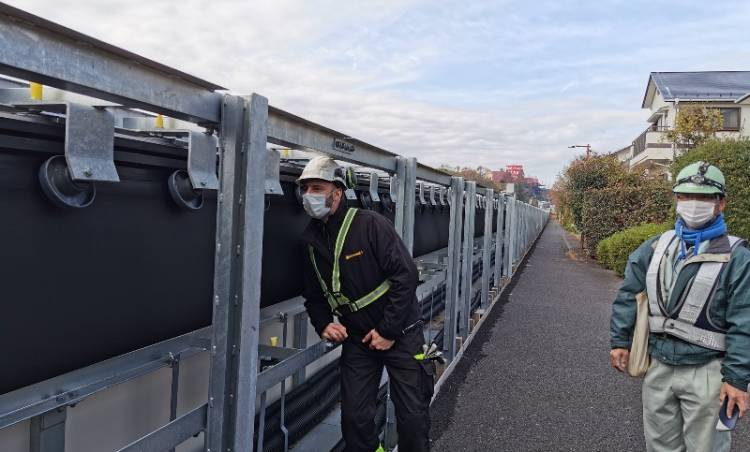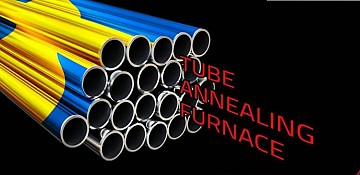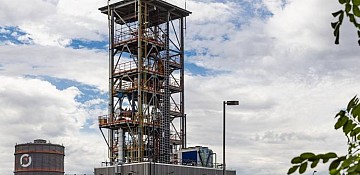
Pouch conveyor belts made by technology company
Continental are being used in a flood prevention project in Machida, Tokyo.
Over the years, numerous rivers in Tokyo have been built over or regulated to create space to live.
The risk of high waters and flooding is increasing as a result. In order to mitigate this risk and
protect inhabitants’ living space, the city is building an underground catch basin that can hold up to
150,000 cubic meters of water. Without it, this volume of water could flood residential areas, shut
down public life and threaten the existence of many people. Continental is contributing to this
project and supplying a special conveyor belt that can be used to transport the material from the
excavation of the collecting basin safely, cleanly and quietly from the construction site in the middle
of a residential area.
Curve-negotiable in the tightest of spaces
To build the basin – 20 meters deep, 190 meters long and 90 meters wide – thousands of tons of
earth and bulk material must first be excavated and transported out of the huge pit. In December
2020, the installation of Sicon pouch conveyor belt with a length of more than 1,500 meters into the
steel structure of the plant was finished. The installation, which is more than 750 meters long will
start operation in a few weeks. The 280 tons of material excavated every hour are transported on
the conveyor belt at a speed of 1.4 seconds per meter across the residential area to a nearby main
street, where it is discharged onto trucks. “The Sicon conveyor belt is a closed system from the
feeding point to the discharging point. It can negotiate curves of up to 180 degrees, making it
extremely flexible when routing the line and adaptable to any environment. Corners and edges can
therefore be bypassed without additional transfer points – curve radii of less than one meter can be
achieved,” explains Gabriele Hennig-Juman from Continental Sales for Conveying Solutions in the
Asia-Pacific region. By using a snaking route, the belt conveyor is also able to overcome large
differences in height in a very tight space.
A low-noise, no-dust and low-emission transport solution
The belt is manufactured in Northeim (Germany) and shipped from there to Japan. The contractors
on site are the local Japanese-German joint venture of Continental “Bando-Scholtz” and Furukawa
Industrial Machinery Systems, a specialist in Japan in steel construction and industrial equipment,
which jointly coordinates and carries out all work for the end customer – the Tokyo Metropolitan.
An international service team from Continental and Bando Chemicals provides on-site support for
the assembly and splicing of the belt and the commissioning of the system. “The pouch conveyor
belt meets particularly demanding requirements in terms of cost-effectiveness and environmental
compatibility. This reliable and clean transport solution takes into account both ecological aspects
and preservation of the quality of life for local people,” says Masaaki Ogino, CEO of the Bando-
Scholtz Corporation.
Without the conveyor system, countless trucks would have to drive through the residential area to
the construction site over a period of months, resulting in a greater CO2 footprint and more noise
pollution, as well as potentially increasing the risk of traffic accidents – particularly in the very
restricted infrastructure of the residential area. The no-noise and low-dust transportation of the
excavation material using a pouch belt is therefore an effective alternative method of transport.
Torrential Rain and Flooding Everywhere
Tokyo has long since grown into one of the largest metropolitan areas in the world – with almost 10
million inhabitants in the city and another 30 million in the surrounding area. Space for living and
working is scarce. This is also the case in Machida, a suburb southwest of Tokyo. Situated
approximately 50 kilometers from the city center, it is home to around 450,000 people. Huge
residential areas stretch across the hilly area of the Tama Hills with the nearby River Tama. For
many years, the city has been regularly affected by torrential rain, high waters and flooding – with
power outages, damage to infrastructure and potential risks for the people living there. The
underground catch basin on the Sakai River is intended to protect residents from flooding in the
future. Completion is planned for 2024.
World Media Group (WMG) Haber Servisi
 Industry News (English)
Industry News (English)
 Industry News (English)
Industry News (English)
 Industry News (English)
Industry News (English)